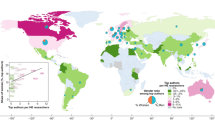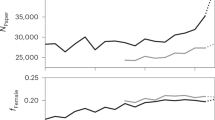Abstract
The performance of Brazilian male and female scientists in three scientific fields was assessed through their publications in the Science Citation Index from 1997-2001. Information on their sex and their ages, positions, and fellowship status was obtained from a census on all Brazilian scientists. The results showed that women participated most in immunology, moderately in oceanography and least in astronomy. Men and women published similar numbers of papers, and they were also of similar potential impact; they were also equally likely to collaborate internationally. Nevertheless, women were less likely than men to receive fellowships to supplement their salaries, suggesting that some sexual discrimination may still be occurring in the Brazilian peer-review process.
Similar content being viewed by others
References
Rossi A. S., Women in science: why so few? Science, 148 (1965) 1196–1202.
Moore K. M., Women.s access and opportunity in higher education: toward the twenty-first century. Comparative Education, 23 (1987) 23–33.
McGregor E., Harding S., Science by whom? In World Science Report, Paris, UNESCO 1996. At http://www.unesco.org/science/publications/wsrw2
Tobias S., Urry M., Venkatesan A., Physics: for women, the last frontier. Science, 296 (2002) 1201.
Kondro W., Canada-few women win new academic chairs. Science, 296 (2002) 2319.
Osborn M., Status and prospects of women in science in Europe. Science, (11 March) 263 (1994) 1389–1391.
Barinaga M., Women in science '94–surprises across the cultural divide. Science, (11 March) 263 (1994) 1468–1496.
Hassan F., Islamic women in science. Science, (6 October) 290 (2000) 55–56.
Vetter B. M., Women scientists and engineers: trends in participation. Science, 214 (1981) 1313–1321.
Lane J. N., Why are there so few women in science. Science debate. at http://www.nature.com/nature/debates/women/women_frameset.html
Kyvik S., Teigen M., Child care, research collaboration and gender differences in scientific productivity. Science, Technology, & Human Values, 21 (1996) 54–71.
Dutt D., How much gender disparity exists in salary? A profile of graduates of a major public university. Research in Higher Education, 38 (1997) 631–646.
Seacgrist L., Disparities detailed in NCI division. Science, 264 (1994) 340.
Etzkowitz H., Kemelgor C., Neuschatz M., Uzzi B., Alonzo J., The paradox of critical mass for women in science. Science, 266 (1994) 51–54.
Lewison G., The quantity and quality of female researchers: a bibliometric study of Iceland. Scientometrics, 52(1) (2001) 29–43.
Webster, B. M., Polish women in science: a bibliometric analysis of Polish science and its publications, 1980–1999. Research Evaluation, 10(3) (2001) 185–194.
Velho L., León E., A construção social da produção científica por mulheres. Cadernos Pagu, 10 (1988) 309–344.
CNPq, Conselho Nacional de Desenvolvimento Científico e Tecnológico. Diretório de Grupos de Pesquisa, Available at: http://lattes.cnpq.br:8888/plataformalattes/index.jsp?menu=diretorio/menu0.htm&url=diretorio/apresentacao.htm
Lewison G., The definition of biomedical research sub-fields with title keywords and application to the analysis of research outputs. Research Evaluation, 6(1) (1996) 25–36.
Lewison G., The definition and calibration of biomedical sub-fields. Scientometrics, 46(3) (1999) 529–537.
Basu A., Lewison G., Evaluation of astronomy and astrophysics research output using a title-word search in place of journal classification. In: Eighth International Conference of International Society of Scientometrics and Informetrics, Sydney, Australia, 2001.
Lewison G., Lipworth S., Rippon I., Austrian biomedical research outputs 1991–2000. Austrian Federal Ministry of Education, Science and Culture, Vienna, 2002.
Gomez I., Sancho R., Moreno L., Fernandez M. T., Influence of Latin-American journals coverage by international databases. Scientometrics, 46(3) (1999) 443–456.
FUVEST, Fundação universitária para o Vestibular. Available at http://www.fuvest.br/
Basu A., Vinu Kumar B. S., International collaboration in Indian scientific papers. Scientometrics, 48(3) (2000) 381–402.
Fernandez M. T., Gomez I., Sebastian J., Scientific cooperation of Latin-American countries through bibliometrics indicators. Interciencia, 23(6) (1998) 328+.
Braun T., Glänzel W., International collaboration-will it be keeping alive East European research? Scientometrics, 36(2) (1996) 247–254.
Lewison G., Fawcett-Jones A., Kessler C., Latin American scientific output 1986–91 and international co-authorship patterns. Scientometrics, 27(3) (1993) 317–336.
Narin F., Stevens K., Whitlow E. S., Scientific co-operation in Europe and the citation of multinationally authored papers. Scientometrics, 21 (1991) 313–324.
Van Raan A. F. J., The influence of international collaboration on the impact of research results. Scientometrics, 42(3) (1998) 423–428.
Ramsay S., Radical reform of UK consultants. salaries announced. The Lancet, (15 August) 352 (1998) 555.
Wenneras C., Wold A., Nepotism and sexism in peer review. Nature, 387 (1997) 341–343.
Bruschini C., Crescimento e crise: trabalho das brasileiras, paulistas e nordestinas, de 1970 a 1985. Ciência e Cultura, 42 (1990) 226–247.
IBGE, Instituto Brasileiro de Geografia e Estatística. Available at http://www.ibge.gov.br
CNPq, Conselho Nacional de Desenvolvimento Científico e Tecnológico. Diretório de Grupos de Pesquisa, ano 2002. Séries Históricas. Available at http://www.cnpq.br http://lattes.cnpq.br:8888/plataformalattes/index.jsp?menu=diretorio/menu0.htm&url=diretorio/apresentacao.htm
Author information
Authors and Affiliations
Rights and permissions
About this article
Cite this article
Leta, J., Lewison, G. The contribution of women in Brazilian science: A case study in astronomy, immunology and oceanography. Scientometrics 57, 339–353 (2003). https://doi.org/10.1023/A:1025000600840
Issue Date:
DOI: https://doi.org/10.1023/A:1025000600840




